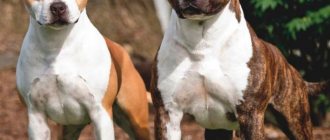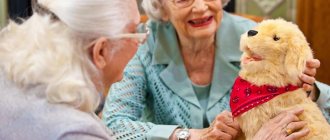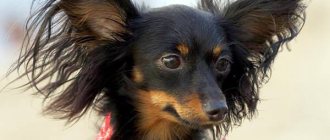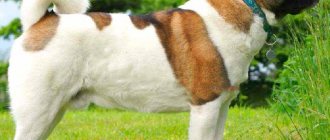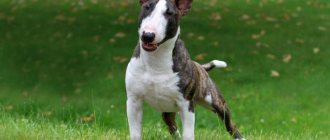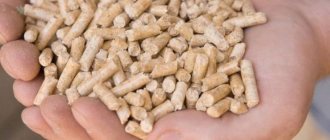Character and temperament
Dogs of the American Staffordshire Terrier breed most often live in families as companion pets. In addition, amstafs are attracted to protect people, premises and territories, and to work in law enforcement agencies. Strong, resilient dogs participate in competitions among animals to move loads over a distance (weight-pulling). All these facts indicate that raising a Stafford is a necessity in order to prevent the emergence of problems associated with the inappropriate behavior of the animal.
Dogs of the American Staffordshire Terrier breed
The best characteristics of the American Staffordshire Terrier breed include their intellectual abilities, fighting instinct, vigilance, and the will to win. Dogs are characterized by strong friendliness and loyalty to their owner. The dogs' favorite pastime is playing with their owner and family members; they are very tolerant and good-natured with them.
Dogs treat strangers with distrust; they will not tolerate a familiar attitude towards themselves. How to properly raise a Staffordshire Terrier will depend on the animal’s ability to communicate with strangers and other animals.
Important! Amstaffs are pack animals, the instinct of dominance is inherent in them by nature.
Amstaff brindle color
Staff training - with an instructor or independently
You can only think about training a Staffordshire Terrier at home if the owner of the dog has sufficient experience in keeping and raising this breed of dog. Raising an obedient and absolutely controllable Staffordshire companion is not easy. Mistakes made during home training can affect the character of the pet and its future fate.
How to wash your dog correctly at home
Dog experts advise:
- If you have to choose how to train a Stafford and settle on home training, you need to call an instructor. He will conduct obedience training and crate training, and also instruct the owner on the rules for raising companion dogs.
- It is better to conduct a general training course on a special site under the guidance of an instructor-trainer. Taking into account the specifics of the breed, he will help the owner find an individual approach to the pet.
The purpose of staff training is to develop a dog’s submissive character and the habits that a person needs.
Important! An American Staffordshire Terrier dog is not a toy, and even a very kind dog can be dangerous for family members.
The best place to raise a Staffordshire Terrier is a training ground
Staff character
In most cases, the character of the Staffordshire Terrier, like other breeds, depends on upbringing . However, there are a number of traits that will be inherent in this dog in any case.
Staff is a dog of moods that can change at lightning speed. The dog can instantly move from a state of rest to combat readiness, and also from a playful mood to alertness. This must be taken into account in everyday communication with your pet.
Staff has an almost unshakable balance. He calmly tolerates playing with children, even if the kids do not treat him very kindly. A properly raised dog will never offend a small child.
In order for a staff to get angry, it is necessary to almost verbally force him to do so. This is a very patient animal .
Many people try to get a guard dog from a fighting breed. The Staffordshire Terrier is perfect for this. This dog's character is fearless. By its nature, this animal practically does not feel pain, which allows it to rush at the offender, even if he is larger than the staff.
Protecting the territory is inherent in this dog's instincts. Even in his sleep, this dog is on alert, listening to what is happening. However, this breed is reserved. The owner will not hear any causeless barking or howling from this dog.
Another positive quality of the Staffordshire Terrier is loyalty to its owner . The staff sees its purpose in serving people and tries in every possible way to please the owner.
In order for a fighting dog not to turn into an aggressor, upbringing should be encouraging. Leadership is also important, which must be in the hands of the owner. Education plays a key role in shaping a dog's character. Therefore, an experienced person should do the training.
One of the key tasks of education is training restraint. It is this quality that will prevent the dog from starting fights with other animals on the street.
The Staffordshire Terrier tries in every possible way to please its owner, so performing tricks is not difficult for him.
Subtleties of training
There are several types of dog training aimed at strengthening conditioned reflexes and ensuring unquestioning execution of commands:
- The dog is given to a specialist, training is carried out without the participation of the owner.
- A canine instructor conducts training at home several times a week.
- The trainer gives the dog's owner step-by-step instructions for training a Stafford. The owner conducts classes with the pet under the guidance of an instructor.
- The owner of the dog independently trains the animal in a special area.
How to properly train a dog at home
It takes dogs at least 4 months to master the minimum set of commands and the basics of correct behavior. In order for a dog to be controllable, it is necessary that it can confidently carry out the commands “near”, “to me”, “lie down”, “sit”, “give”, “fu”.
The result of raising a staff should be a clear understanding for the animal that there is an owner in the house, and it is not him. To permanently subjugate a dog to a person, a minimum course of training is not enough. It is necessary to constantly load the dogs with training.
Important! For a puppy to grow into an obedient dog, training to commands alone is not enough. The pet must be provided with proper care and adequate nutrition, and the owner must have unlimited patience.
Staff training
The psychology of dogs is complex and requires a lot of attention. However, the owner, spending enough time every day training, eventually begins to notice the slightest changes in the pet’s mood. The change in mood becomes noticeable in the gaze and characteristic movements. An attentive owner always knows what the dog is going to do in a few seconds.
The Staffordshire Terrier is a dog that respects hierarchy . For him, his family is his pack. And it depends only on the owner what place the dog will take in this pack. A common mistake that owners make is to over-encourage the animal when following commands correctly. By allowing the dog to lie on the sofa as a reward, the owner thereby “loses ground” in the dog’s eyes. Encouragement should not go beyond what is reasonable, and training should always be based on subordination.
Training a Staffordshire Terrier is a responsible task, so many owners prefer to turn to dog trainers for help. However, it is worth understanding that the specialist’s work is aimed largely at teaching the owner how to interact with the animal. Errors during the course are the mistakes of the owner, not the dog, as evidenced by numerous reviews about the breed.
There are several types of training on the site:
- General course. Involves learning basic commands: “Fu,” “Sit,” “Pick.” The dog learns to understand the owner, and the owner, in turn, correctly sets the tone for training.
- Manageable city dog. Allows you to master the basics of behavior in public places, as well as the commands and gestures of the owner.
- Protective guard service. More complex course of study. The nature of the staff means constant interaction with people, so this course is not always suitable for this breed.
- Bodyguard. The dog is trained as a personal guard. The course is suitable for owners of sporting dogs, however, it is not suitable for ordinary pets. Having turned the dog into a bodyguard, owners are faced with the pet’s aggression towards random passers-by, which can provoke problems.
The price for the course will depend on the focus of the lessons and the reputation of the dog handler.
How to raise a Stafford puppy at home
Lessons for raising an Amstaff puppy should last at least until the animal reaches the age of 1.5 years.
First 3 months of life
From 3 weeks of age, the socialization of the animal begins. The pet gets acquainted with people and objects around it. The owner should go outside with him so that the puppy gets acquainted with animals and birds, children and adults, and gets used to the noise of cars and loud sounds. A puppy at this age must understand that its first protector is its owner, and that it is he who gives the treat.
At this age, a puppy’s bones and tendons are not yet fully formed, so it is necessary to ensure that he does not jump from a height, does not fall into holes, does not climb over high obstacles, or gets overtired.
Important! During this period, children will be taught a nickname, hygiene, the toilet, their own place, walking on a leash and without it, and playing independently with toys.
A puppy learns best while playing.
How to raise a 4-5 month old staff
Puppies of this age can be shy. The child should not be allowed to show aggression. When visiting an unfamiliar place or meeting strangers, the pet is given the opportunity to look around and calm down.
During the same period, the habit of performing simple voice commands is reinforced. If the “come to me” command is not followed, painless coercion is used by adjusting the length of the leash. After performing the required action, the dog must be praised. If the puppy does not comply with the “place” command, he is taken to his place using a leash, and then given a treat.
Raising an Amstaff puppy from six months of age
Training dogs at six months of age becomes more complicated, the requirements become more stringent. Not only pulling on the leash is allowed, but also jerking, gentle pressure on the body, and gentle pressure with a twig. During this period, dogs are taught to use sign commands.
At the age of 8-9 months, dogs begin to show signs of puberty. If the pet is not used to following commands by this age, difficulties may arise during training. The dog can be stubborn, the owner has to give commands in a more stern voice, and carry out exercises many times.
Training a pet up to 1.5 years old
By the age of 12 months, the staff will have formed certain habits, he will develop his own view of his owners and the world around him. The pet begins to separate its own from the strangers, understands who is big and can pose a threat, and who is small and will not fight back. Animals are able to independently choose their own course of behavior.
Important! The owner must promptly correct the pet’s incorrect behavior during walks and training. Dog training should become more frequent and intense.
Care and maintenance
Representatives of the American Staffordshire Terrier breed are considered quite unpretentious. They can live both in a city apartment and in a country house. However, with the latter option, the dog cannot be kept on the street - put on a chain or in an enclosure. Amstaffs should only live indoors where they have a spacious, warm place without dampness or drafts.
Ear cropping of Staff puppies is an important point in dog ownership. Not so long ago, this procedure was considered mandatory, since docking was provided for by the breed standard. Now in many countries cupping is allowed only for medical reasons. If the owner nevertheless decides to give the pet an appearance according to the standard, then it is better to carry out this procedure at the age of 1.5 to 3 months.
During this period, dogs are not as sensitive to pain, are less likely to develop complications, and are also more likely to get the correct shape of their ears. Ear cropping surgery is performed under general anesthesia. Afterwards it is recommended to wear a protective collar. The veterinarian removes the sutures from the ears a week after the procedure, but to avoid bleeding, the head will remain bandaged for some time.
For a balanced diet for their pet, the owner can choose both ready-made food and natural food. However, when feeding natural food, it is necessary to add vitamins and minerals. American Terriers are a breed prone to overeating, so the owner needs to be especially careful when planning their diet and diet.
The basis of the diet (about 75%) of an adult Staffordshire Terrier should be raw, lean meat, which must be cut into small pieces before serving.
Meat can be diluted with the following products:
- porridge from rice, corn, buckwheat and millet cereals;
- well-cooked offal;
- vegetables;
- greenery;
- fruits;
- dairy products;
- sea fish without bones.
It is strictly forbidden to give representatives of the breed:
- legumes;
- sweets;
- spices;
- fat meat;
- smoked meats;
- boiled potatoes;
- porridge from pearl barley and oatmeal.
For full development and muscle growth, American Staffordshire Terrier puppies need to be fed very well. About 30% of your puppy's diet should be lean meat. Next, you need to gradually introduce all foods from the diet of an adult dog. In addition, diet is very important for puppies.
Usually newborn babies feed on mother's milk. In the absence of it, puppies two months and younger should eat 6 times a day, from 2–4 months – 5 times, from 5 to 11 months – 4 times, and per year, Staffy puppies should eat no more than 3 times a day. The dog is switched to two meals a day after 18 months.
Staffordshire Terriers, like all active dogs, love long walks, during which they can run, play and carry out tasks for their owner. In the warm season, you can include swimming in open waters in your walk. If the dog does not have the opportunity to release its pent-up energy on a walk, it will begin to damage things in the house.
Education and training should be a mandatory part of keeping a Staffordshire Terrier. Staffies are very smart dogs. They quickly understand what is wanted from them, but due to their natural stubbornness they may refuse to carry out some commands. In order to properly raise a Staff puppy, you need to build a hierarchy almost from the first days of the baby’s stay in the house, becoming an unconditional authority for him.
Stafford training should be regular (at least 2-3 hours a day) and consistent. If the owner does not have the skills and knowledge necessary for training, it is imperative to contact an experienced dog handler.
Hygiene
Hygienic care for representatives of the breed is minimal and boils down to washing, caring for hair and eyes, cleaning ears and teeth, and trimming nails. Amstaff should be taught these mandatory procedures from a very early age.
Caring for the coat of Staffordshire Terriers is very simple: you need to brush the dog weekly with a special massage brush. It is not recommended to bathe Staffies completely more than once a month - this can harm their skin and coat. After each walk, it is enough to wash your paws with a special shampoo. In addition, we must not forget about regular treatment of wool from external parasites.
Discharge in the corners of the eyes should be removed daily with a piece of bandage soaked in boiled warm water. Ears should also be checked regularly for dirt and cleaned weekly with a cotton pad soaked in a special solution.
Teeth brushing should be done weekly using special toothbrushes and toothpastes. Staffordshire Terriers' nails usually wear down on their own, but if this does not happen, they need to be trimmed carefully.
How to wean yourself from bad habits, amstaff punishment
Dogs begin to wean themselves from bad habits from puppyhood. To prevent your pet from chewing on things when teething, hard toys are bought for him. An adult dog is given boiled, hard, natural bones to chew on. To prevent loud barking, use the commands “fu” and “no”.
A dog that is capable of causing chaos in the house and has nothing to do in the absence of its owners is placed for this period along with toys in its personal cage. Dogs that have caused chaos in a house cannot be beaten; they are spoken to in a stern voice.
It’s easy to tell by the dog’s face whether he understands or not why the owner is angry. The owner must always be the leader for the pet and never give in to the animal. The owner's gaze and stern voice will force the pet to obey.
The look of the Staffordshire Terrier is very expressive
Training courses
Special sports physical exercises used in training American Staffordshire Terriers include:
- agility - overcoming an obstacle course;
- towing - training in cargo transportation;
- weightpulling - moving heavy objects;
- canicross - towing a running person;
- mondioring - performing basic commands in a stressful situation for the dog;
- frisbee - catching a disc thrown by a person.
Additional Information! There are courses on training dogs for protective guard duty. Dogs that have completed the ZKS training course receive diplomas indicating that the animal will not be considered guilty if it bites a person who has attacked its owner.
Staffordshire Terrier in tow harness
At what age can you start?
Education begins with the process of socialization. First you need to teach your baby:
- To his new nickname;
- To the place where he will sleep;
- Collar and leash.
Kids quickly get used to new things and explore the world with interest. If a child behaves eccentrically, it is enough to send him to a place where he will have to be left alone for some time.
If you punish a dog, then the moment he goes home, you can no longer touch him or scold him. His place is his fortress, where he must know for sure that he is protected from the outside world.
It is better to separate a place for sleeping and where the puppy will eat; his bowls should be in only one place, and he should eat at the same time. Moreover, people in the family eat first, and then animals. Adult pets also eat first, all in order of seniority. From a very early age, teach him that begging is prohibited and do not give him pieces while you are at the table.
We suggest you read: How and what is the best way to feed a Yorkshire Terrier
Walks
After your baby has learned his name and settled into his new home, start going outside wearing a collar and leash. Walks should not be long, preferably if you go out not only along one route, but also in new places. During this period, the puppy should begin to get used to it, not only to walking, but also to the outside world. He must get used to:
- Loud sounds;
- Machines;
- To strangers;
- Other animals.
Be careful if you let him off the leash until he has mastered the basic commands, he will definitely not obey. It will be difficult to catch him, most likely he will think that you are just playing with him and will not approach.
Training for the Staffordshire Terrier begins at 2.5 - 3 months. Start by learning the simplest commands:
- "To me";
- "It is forbidden";
- "Ugh";
- "Place";
- "Near";
- "Sit";
- "Lie";
- "Wait".
The training time should not exceed 40 minutes, otherwise he will get tired quickly and will not absorb information well. Alternate training, always with active games, so that he can relieve stress and relax. Classes should be regular, paying attention not only to new things, but also to consolidating the material covered.
Dogs especially love the process of communication with the owner; the moment the puppy is with a person, he is already happy. Remember this, the dog must receive enough attention, affection and care.
Choosing the right moment to start training an American Staffordshire Terrier is not too difficult. Already at 2 months the puppy is able to:
- respond to your name;
- know the location of the bed;
- run up when the owner calls;
- wear a collar or harness;
- walk on a leash;
- observe the rules of hygiene.
Parenting mistakes
When raising a Staffordshire Terrier, it is important to pay attention to the animal's emotions. You cannot start training while the dog is nervous. Before training your staff, you should make sure that the dog is healthy and not tired.
Classes will be ineffective if they are rare or irregular. Training Staffords should be carried out by people who have experience with fighting breeds and know how to subdue them.
Important! Strict conversations about the dog’s misdeeds should be carried out with it immediately after it has misbehaved. After a while, the dog simply will not understand why he is being scolded.
Raising a Staffordshire Terrier
As already mentioned, raising a Staffordshire Terrier plays a key role in shaping the character of the animal. Training this breed is a responsible matter.
Staff dogs have strong leadership qualities, so from the very beginning of training, the owner needs to take an authoritative position. Only by letting the puppy understand who is in charge in the “master-dog” union can one achieve absolute obedience from the pet. The owner will also require remarkable endurance, since this breed is very persistent and will test the owner’s decision more than once.
Socialization of a puppy should occur from the very first days of meeting its new owners. It is necessary to give your pet the opportunity to explore the world around him and become familiar with various situations. Walks should occur as often as possible. It is best if the puppy regularly finds himself in a crowd.
Meetings with other animals at a young age should be limited. Introducing a puppy to foreign dogs should begin at the age of six months. If the dog is wary or scared, the owner needs to be patient. Aggressively encouraging a frightened puppy to act can lead to the animal growing up to be hot-tempered and inappropriate.
Before the age of one and a half years, special attention must be paid to the dog’s understanding of human speech. The dog must learn to distinguish not only commands, but also the intonation of the owner’s voice. The owner must express demands in a firm, confident voice. A person's word must be unshakable. The puppy is playful by nature and will try to convince its owner, thus testing the team's strength. If during this period the owner gives in, the dog will sense the absence of a leader and try to occupy a free niche.
There is also a phenomenon called “rebellion” in the Staffordshire Terrier’s temperament. Usually the staff begins to rebel during puberty. Disobedience manifests itself in attempts to ignore the strongest member of the family, as well as the one who puts the most pressure on the dog. The dog is trying to take over the lead, and this is normal. Before this period, it is extremely important that the owner's word has the greatest weight.
Physical influence in raising a Staffordshire Terrier is unacceptable. Not only is it useless, but it can also lead to the opposite result. The young animal will understand that conflict situations with humans must be resolved through the manifestation of force. It’s also not worth shouting at the “intruder.” If the dog is rebelling, the most that can be done is to shake the puppy thoroughly. But the best method is still a clear command, no matter how many times it needs to be repeated. Owner reviews are unanimous: patience and only patience.
Another good way to curb a young dog is to look directly into the eyes . It’s worth watching until submission appears in the dog’s gaze.
Cost of training classes
In Moscow and the Moscow region, the cost of home training starts from 2000 rubles, at a trainer’s site from 600 - 1000 rubles* Some dog trainers, such as Antoine Najarian, conduct paid and free Skype consultations; the cost of on-site services is negotiated directly with the customer.
The peaceful coexistence of large breed dogs with the owner’s family and with surrounding people and animals depends not only on hereditary temperament and character. It is important that the upbringing and training of dogs instill in them a model of behavior that does not allow them to show aggression and dominance. Home lessons with Amstaffs may give the desired result, but it is still better to trust the training of these dogs to professionals.
*Prices are current as of December 2021.
